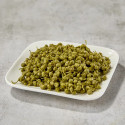Sansho (Xanthroxylum piperitum) is undoubtedly one of the most popular spices, originating in Japan. Its refined aroma and pungent taste add depth to Japanese cuisine. There are many different types of sansho in Japan.
Despite its name, this spice is not part of the pepper family, but rather the Rutaceae family (citrus fruits). Sansho has been widely used in Japanese medicine since ancient times. It is known for its high polyphenol, sanshool, and shansho amid content. The polyphenol in sansho has an antioxidant effect.
In Japan, it is recommended for the prevention of cancer, heart disease, and blood circulation disorders in the brain, and is said to improve blood circulation. Sanshool activates the internal organs and improves digestion. It is also known as a fat burner and is very popular as a dietary supplement and slimming aid.
Our sansho berries belong to the sansho grape category because they grow in clusters like grapes. Green sansho berries are harvested in May. They are recognizable by their unique fruity taste, a delicious combination of lemongrass, lemon, and mint, with very peppery spicy notes. Here, the sansho berries are whole.
Since ancient times, sansho has been used as a natural preservative for meat and fish, preventing unpleasant odors and spoilage, and as an appetite stimulant.
Its elegant fragrance and pungent taste make it ideal for meat or fish tartares or shellfish, tofu, mayonnaise, grilled fish, sauces for duck or pork and for stewed red meats, kabayaki eel, chocolate desserts... all enhanced with a spicy and colorful touch of sansho berries. Eaten as they are, they give a slight numbing sensation on the tongue, with a slight tingling sensation reminiscent of sparkling wine.
















































